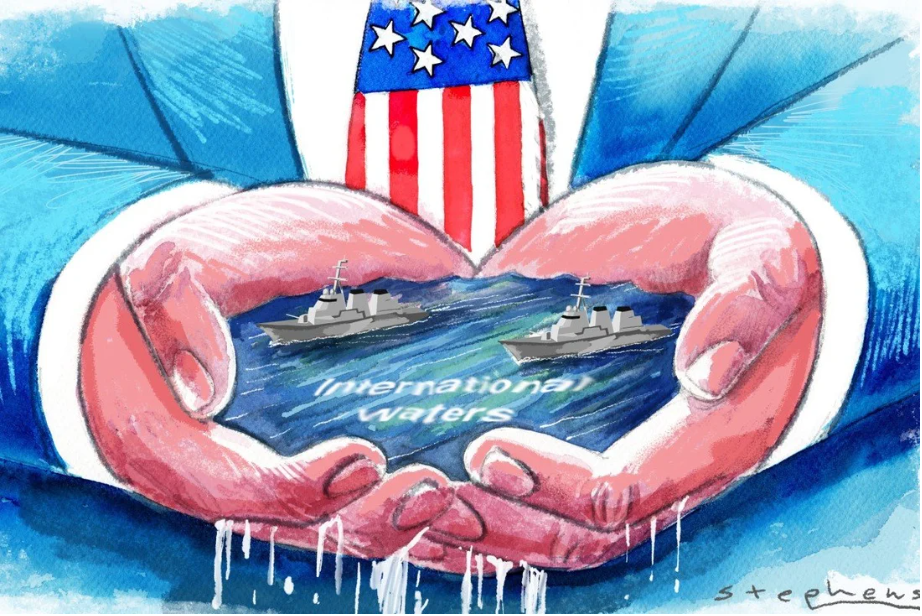Tian Shichen: Founder and president of the Global Governance Institution and director of the Center for International Law of Military Operations in Beijing, a China Forum expert.
Chinese foreign ministry spokesman Wang Wenbin’s assertion that there is no such thing as “international waters” in international law and rejection of the Taiwan Strait as international waters have raised concerns and led to an outcry in both the United States and Taiwan.
The US State Department insists the Taiwan Strait is international waters where high seas freedoms, including of navigation and overflight, are guaranteed under international law. Taiwanese foreign ministry spokeswoman Joanne Ou also rejected Beijing’s claim, to stand firmly with the US.
Beyond the official disputes, there are media reports that cite Wang’s statement as describing China’s position as claiming sovereignty over the entire Taiwan Strait. Social media accounts in mainland China also ignorantly advocate treating the entire strait as an internal sea, which is not acknowledged in any official Chinese policy.

The 1982 United Nations Convention on the Law of the Sea (UNCLOS) is considered the “constitution of the oceans” governing all maritime activity. Does it have any regulations on “international waters”?
If not, why does the US persist in using this term, not only with regard to the Taiwan Strait but also in other areas beyond territorial seas? And, what is the legal status of the Taiwan Strait? These are questions that need to be addressed to understand the different interpretations and applications of the law of the sea between the disputing parties.
Search the full text of UNCLOS and you will find no provision for “international waters”. However, this term is not new to the US navy or marine lawyers.
The Commander’s Handbook on the Law of Naval Operations, published by the US Navy, states: “For operational purposes, international waters include all ocean areas not subject to the sovereignty of a coastal state.”
Clearly, “international waters” is an operational, rather than legal, term. Since it is not a legal term, it’s not surprising that there are no provisions for it in UNCLOS.
This supports Wang’s statement that: “There is no legal basis of ‘international waters’ in the international law of the sea.” And it invites the question of why the US started using the term instead of keeping in line with UNCLOS.
It is not simply because the US is not a party to UNCLOS. The answer lies in the same US Navy handbook, which asserts that: “All waters seaward of the territorial sea are international waters in which the high seas freedoms of navigation and overflight are preserved to the international community. International waters include contiguous zones, EEZs [exclusive economic zones] and high seas.”
By reclassifying contiguous zones and EEZs alike as equivalent to the high seas for operational purposes, the US claims freedom of navigation and overflight without being tied down by the obligations demanded.
The key point is that these freedoms, in the eyes of the US, include activities ranging from normal passage to military exercises.
So the US will carry out military activities in the contiguous zones and EEZs of coastal states without paying attention to its obligations. It is in this sense that the term “international waters” serves as a panacea for Washington, allowing it to maintain its maritime hegemony, which relies heavily on the mobility of its warships in the world’s oceans.
Another incorrect view is to regard the US sailing of its warships through the Taiwan Strait as carrying out freedom of navigation operations (FONOPs) to challenge “excessive maritime claims” by China.
The US freedom of navigation programme started in 1979 under the Carter administration and its annual reports are freely available on the US defence department’s website. Comb through these and you will find no specific record of challenging excessive Chinese maritime claims in the Taiwan Strait.
Finally, what exactly is the legal status of the Taiwan Strait? Is it a strait used for international navigation or an internal sea (as wrongly advocated by some social media users)? Again, we have to come back to UNCLOS, where the legal regime of straits used for international navigation is specifically regulated.
Accordingly, there are two types of strait used for international navigation between one part of the high seas or an EEZ and another part of the high seas or an EEZ.
The first type are straits that are completely overlapped by the territorial seas of a coastal state or states and which are subject to the legal regime of transit passage. The Strait of Malacca is one example of this.
The second type are straits not completely overlapped by territorial seas, with a route through the high seas or an EEZ suitable for international navigation, and which are subject to high seas freedom of navigation and overflight. The Taiwan Strait and Miyako Strait are two examples.
Still, UNCLOS stipulates that the exercise of such freedom and rights is subject to obligations, including under the applicable laws and regulations of the coastal states. Take the Taiwan Strait, for example. There is an EEZ corridor through it, and the waters are divided into several zones including internal waters, territorial sea and contiguous zones.
The principle of innocent passage applies to the designated territorial sea in the Taiwan Strait, while the high seas freedoms, of navigation and overflight, apply to the EEZ. That is why Wang said that, “China has sovereignty, sovereign rights and jurisdiction over the Taiwan Strait.”
He meant that China has sovereignty over the internal waters and territorial seas in the strait, and sovereign rights and jurisdiction over the EEZ part. However, some media mistakenly or deliberately cited his statement as saying that China claims sovereignty over the entire Taiwan Strait.
(This article was first published on South China Morning Post on June 21, 2022.)
